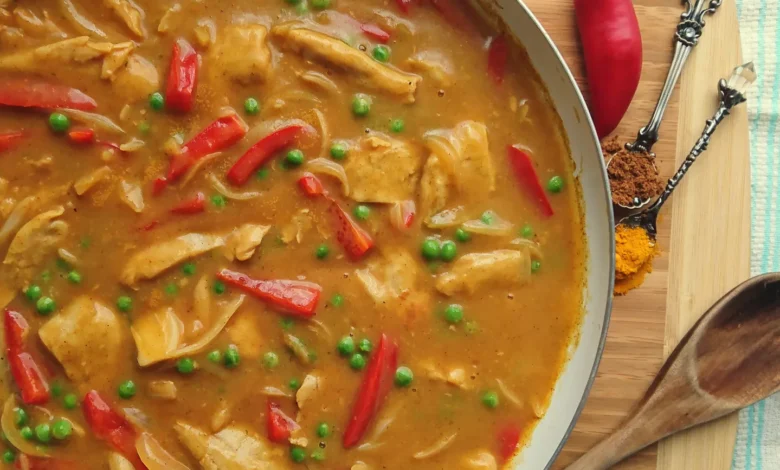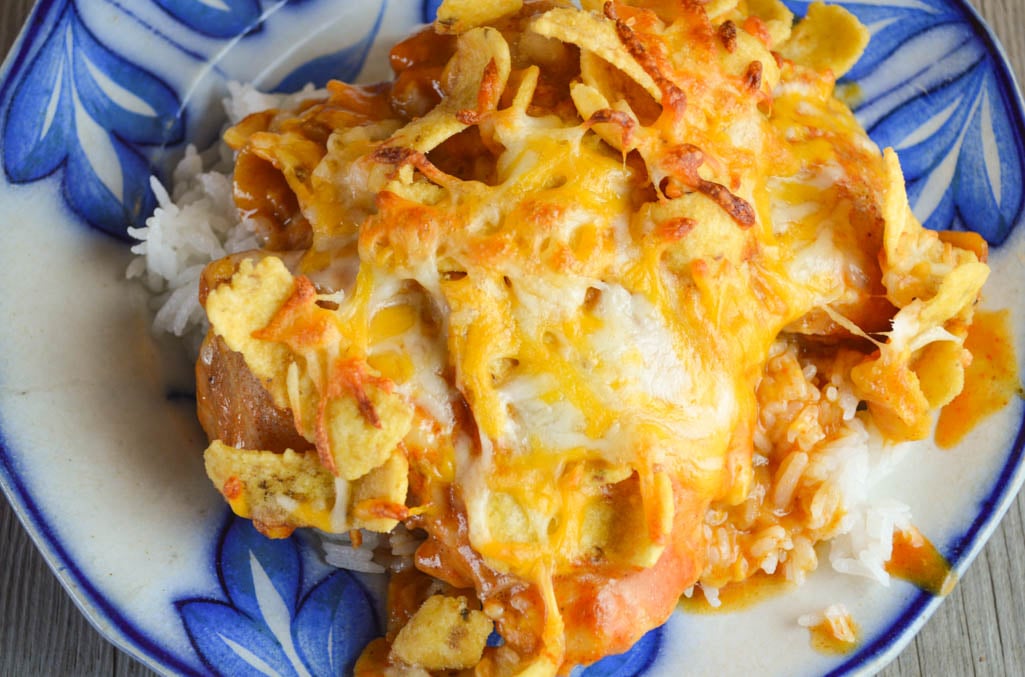Chinese Takeaway Curry Sauce: Authentic Recipe for That Classic UK Flavor

If you’ve ever ordered from a British Chinese takeaway, chances are you’ve experienced the comforting allure of Chinese takeaway curry sauce. Smooth, golden, and mildly spiced, this sauce has become an essential part of the UK’s culinary culture. Whether it’s poured over chips, paired with fried rice, or used as a dip for crispy chicken balls, the rich flavour instantly evokes nostalgia for family takeaway nights.
What makes this curry sauce so beloved is its unique balance of flavours. Unlike traditional Indian or Thai curries, the Chinese takeaway version is milder, creamier, and subtly sweet, with hints of aromatic spice that never overwhelm the palate. Its charm lies in its simplicity — an approachable curry that appeals to nearly everyone, regardless of spice tolerance.
In this guide, we’ll explore everything you need to know about Chinese takeaway curry sauce: where it comes from, what ingredients define it, how to make it at home, and the many delicious ways to serve it. By the end, you’ll be ready to recreate that authentic takeaway taste right in your kitchen.
The Origins of Chinese Takeaway Curry Sauce
The story of Chinese takeaway curry sauce begins in post-war Britain, when Chinese immigrants brought their culinary traditions to the UK. They adapted Cantonese-style dishes to suit local tastes, leading to a beautiful fusion of Eastern technique and Western preference. British diners were already fond of curry, thanks to historical ties with India, and the Chinese takeaway chefs cleverly introduced a milder, smoother version of the dish that quickly became a hit.
This version of curry sauce was designed to be comforting and versatile. It could coat crispy chips, enhance fried rice, or serve as a gravy-like side dish for meats and vegetables. Over time, the recipe evolved to reflect regional preferences — some areas preferred thicker, spicier versions, while others favoured lighter, more delicate blends.
Today, the Chinese curry sauce is a cultural icon in the UK, as synonymous with Friday-night takeaways as salt-and-pepper chicken or sweet and sour pork. It represents a meeting point between two culinary worlds — the gentle heat of curry powder paired with the umami richness of soy sauce and stock, producing a sauce that’s both familiar and exotic.
Key Ingredients That Define the Flavor
The beauty of Chinese takeaway curry sauce lies in its simplicity. The core ingredients are few, but when combined, they deliver that unmistakable taste you can’t quite forget. The main flavour base begins with onions, garlic, and ginger — the aromatic trio that gives the sauce its depth and fragrance. Sautéing these ingredients until golden unlocks a sweetness that balances the spice.
Next comes curry powder, the star of the show. Most takeaways use a British-style curry powder — mild or medium — which includes turmeric, cumin, coriander, and fenugreek. These spices bring warmth without overpowering the sauce. Some chefs add a pinch of garam masala for extra complexity.
The sauce gets its silky texture from cornflour (cornstarch), which thickens the mixture to that familiar takeaway consistency. Stock or broth, often chicken or vegetable, forms the liquid base and gives it that savoury umami note. A dash of soy sauce adds saltiness, while sugar or even a spoon of mango chutney provides the subtle sweetness that rounds out the flavour.
Optional additions like chili flakes for heat or coconut milk for creaminess can tailor the sauce to your liking. Whether you want vegan, gluten-free, or classic, small tweaks ensure this sauce can suit any dietary preference.
Step-by-Step: How to Make Chinese Takeaway Curry Sauce at Home
Making Chinese takeaway curry sauce at home is surprisingly simple and takes less than 30 minutes.
Step 1: Sauté the Aromatics
Begin by frying finely chopped onions, garlic, and ginger in a little oil until golden brown. This step is crucial for developing that deep, savoury foundation.
Step 2: Add the Spices
Sprinkle in your curry powder and turmeric, stirring for a minute to release their aroma. If you prefer a more robust flavour, add a pinch of chili powder or garam masala.
Step 3: Add the Stock
Gradually pour in chicken or vegetable stock while whisking to avoid lumps. Bring the mixture to a gentle simmer.
Step 4: Thicken the Sauce
Mix cornflour with cold water to form a slurry and stir it into the simmering sauce. The sauce will begin to thicken to that signature takeaway consistency.
Step 5: Season and Blend
Add soy sauce, sugar, and salt to taste. For a smoother finish, blend the sauce before serving.
Serve it warm over chips, rice, noodles, or crispy chicken. The rich, velvety texture and balanced flavour make it an instant crowd-pleaser.
Variations and Serving Suggestions

One of the best things about Chinese takeaway curry sauce is its versatility. It pairs beautifully with almost anything — from crispy fries to fluffy rice.
Regional differences in the UK have given rise to unique variations. In the North, the sauce tends to be thicker and heartier, often served generously over chips. In the South, it’s lighter and more fragrant, sometimes poured over chow mein or mixed vegetables.
It’s also incredibly flexible in the kitchen. Pair it with chicken, beef, prawns, or tofu, or drizzle it over fried rice and noodles. Use it as a dipping sauce for spring rolls or even as a gravy for roast potatoes. For a twist, try adding a touch of coconut milk for a creamier, tropical note.
If you make a big batch, the sauce keeps well in the fridge for up to three days or can be frozen for up to a month — perfect for quick midweek meals.
Nutritional Overview and Healthier Alternatives
While traditional takeaway curry sauce can be indulgent, making it at home gives you full control over its nutrition. A standard portion of Chinese curry sauce typically contains moderate calories, with most coming from oil and thickening agents.
For a lighter version, use vegetable stock instead of chicken and reduce the oil. Swap sugar for honey or maple syrup for a natural sweetness. To make it vegan, simply use plant-based stock and check your curry powder for animal derivatives.
Homemade versions are also far lower in sodium than takeaway ones, making them healthier for regular consumption. You can even add finely blended carrots or bell peppers to boost fibre and natural sweetness — enhancing both flavour and nutrition.
Expert Tips for Perfecting Your Sauce
Achieving that authentic takeaway taste takes a few insider tricks. Always toast your curry powder briefly before adding liquid — this enhances its aroma and removes any raw spice bitterness. Simmer the sauce slowly to let the flavours meld together beautifully.
Avoid over-thickening; the sauce should coat a spoon smoothly, not sit heavy. If it becomes too thick, add a splash of hot water or stock to loosen it. Another expert secret is to let the sauce rest overnight in the fridge — this deepens the flavour, much like a stew.
Above all, taste as you go. A balance of savoury, sweet, and mild heat is the key to an authentic Chinese takeaway curry sauce that keeps you coming back for more.
Conclusion
Chinese takeaway curry sauce isn’t just a condiment — it’s a cultural comfort food that bridges East and West. Its humble ingredients and simple preparation hide a depth of flavour that’s stood the test of time. Recreating it at home means you can enjoy that nostalgic takeaway experience whenever you wish, tailored exactly to your taste.
With the right ingredients, patience, and a touch of creativity, you can bring the magic of your favourite takeaway straight to your kitchen.
FAQs About Chinese Takeaway Curry Sauce
What makes Chinese takeaway curry sauce different from Indian curry?
It’s milder, sweeter, and thicker, with less spice and more savoury-sweet balance.
Can I make it vegan or gluten-free?
Yes — use vegetable stock and gluten-free soy sauce.
How do I make the sauce thicker or thinner?
Adjust cornflour for thickness or add stock to loosen.
Can I freeze it?
Absolutely. It keeps up to a month when frozen in airtight containers.
What’s the best curry powder to use?
A mild or medium British-style curry powder works best for authentic flavour.
You May Also Read: Aquatic Plants Low Light



